|
David from Brigadier Audio Design and my very good friend and hifi freak Fredrik followed in the Kyron boys footsteps and came to my place for a listen of my revamped 30 years old Microphase speakers. We listened to a wide variety of music and both Dave and Fredrik were kind enough to write a little review after our three hour listening (and drinking French red wine...) session. Obviously, it was a very enjoyable evening! David's review: "Last week I was invited to listen to a pair of Microphase speakers originally designed by Jean-Marie Liere almost 30 years ago. The configuration I listened to consisted of two satellite speakers with an active sub using 10" XXLS from Peerless with its own 200w amplifier. The satellites were perched on two column subs which were not being used at the time. Jean-Marie explained the Microphase speakers had recently undergone an upgrade from an Audax TW51 tweeter to a 1” Vifa tweeter which is now available as an upgrade kit for $199. While I did not hear the original tweeter, the 1” Vifa seemed to be doing a very good job of extending the range beyond the mid/bass driver. The system consisted of NAD preamp, Bryston 3B amplifier and OPPO player which gave the Microphase speakers every chance of sounding good, and they did. The Bryston 3B provides the necessary current to make the Microphase sing while the Oppo delivered a variety of material in different formats that showed off the speakers at their best. This included an excellent track by a famous French percussionist Jean-Pierre Drouet, which I particularly liked. In summing up the Microphase speakers, I think it’s true that a lot of audiophiles listen with their ears, but also their eyes, so when I set eyes on these small satellites I was sceptical about their ability to deliver a sonic performance that could pass as 'high fidelity'. I was wrong, the Microphase speakers are the epitome of the under dog, and today still punch far above their weight with dynamics that would puts some floor-standers to shame. I’ve always liked the form factor of two satellites with a sub as a way of getting bass extension with the elegance of a small bookshelf. The only challenge with this configuration is getting the integration right, for the most part the Microphase satellites integrated well with the sub, there was only one occasion were I could isolate the low frequencies as being off to one side where the sub was located. If these are anything to go by I look forward to Jean-Marie's next attempt to better the Microphase speakers, hopefully this time with stereo subs.” Fredrik's review: I admit to having a soft spot for small speakers. Apart from the obvious WAF factor I think that small boxes often delivers a cleaner and more accurate sound. More detail with better 3D imaging compared to when you are in room with 5 foots worth of grunt. A small speaker should also result in happier neighbours if you live in an apartment block, and also music experience that works better in your average living room. This time we are in a large L shaped open room with the Microphase speaker shooting across the shorter length of the room. Comfortably placed in a large couch a good 4 meters away from the speakers as we start a 3 hour session. This is a musical and fun speaker. It has a slightly pronounced upper register that gives very live feel especially when playing some of the jazz tracks. The room is carpeted and sound stage feels natural with great depth and with the active subwoofer integrating very well. As we move from jazz to female vocal to drums to rock this small speaker proves is very easy to live with. Female vocals lacks a touch of bottom meat but the upside is the clarity and how it is delivered. There absolutely nothing woolly with these units and with a very large sweat spot making for a large listening area. Only when we start to play drums at a sound volume fit for house party the small woofer/midrange started to struggle to keep the crescendos neat. Still as the active sub is not breaking out in sweat I am more at this point worried about the neighbours then the speakers peak capacity. I really enjoyed this music session and I think this speaker always will have a very broad appeal with music lovers, including partners and neighbours. My comments: Well, I have to admit of being pretty proud of what can be achieved with the right design brief and be able to keep these speakers relevant after 30 years of great service. We ran out of time to try the passive subwoofer that support the satellites, but I am now planning another more structured session where we will first listen to the original SATs with the AUDAX tweeter and the passive SWS sub, then with the updated tweeter, then with the new active subwoofer. Stay tuned! UPDATE JANUARY 2018 By now, we have released two versions of our new SATs appropriately named SAT MK2 and SAT MK2 Signature. You can read more about them on our new website: You can also find out about the genesis of this new products on this website here
We finally have the video of the interview which took place a week ago at Len Wallis Audio. We will go through the setting up process for the Kronos, listen to some music and get the feedback from Brad Serhan, a famous loudspeaker Australian designer, who founded Orpheus Loudspeakers in 1984, and now works independently under the Brigadier Audio Group banner together with David Allen. Leon and Lee will talk about their design choices in terms of drivers, Class D amplifiers, DSP engine and mechanical/industrial design. This is the first of a series of video interviews with interesting and relevant people to our quest for the elusive perfect sound that French Vintage Hifi intends to bring to you over time. We hope you will find it instructive and entertaining, even though the quality of the video and lighting could (and will...) be improved. We certainly had fun going through this exercise and we welcome your feedback.  Life has always surprises in store for you… Preparing a trip to the USA for the CES and a bit of R&R with my family beforehand, I stumble upon an audio site that I didn’t know about and which was going into a great deal of details about open baffle and point source speaker design: www.linkwitzlab.com I have been researching open baffle speakers for my blog after reconnecting with my friend Alain Wacquet who designed such speakers in the 80s under the AW Audio brand and with whom I shared many a hifi show in France at the time. His designs were really “out there” at the time and he had just shared with me a review of his penultimate design: the EA-16, released in 1987. (His last design in 1995, the Transparence, was produced in very limited quantities, and cannot be called a production model, really...) I was also trying to find out if it would be possible to listen to the Emerald Physics speakers at the CES. They use digital filtering and equalization to produce amazing results as I read in many a review. Unfortunately, this didn’t happen... The funny thing is that the name of Linkwitz Lab should have been an instant hit, but it took me a couple of emails with the owner of the website for the penny to drop: I was indeed talking to Siegfried Linkwitz, who made himself famous by teaching the KEF engineers about group delay and transient response together with his colleague Russ Riley in the 70s when KEF was shopping around to buy a state-of-the-art FFT analyser and ended up with Hewlett-Packard in California, where Siegfried and Russ were working at the Microwave Division in Santa Rosa. I encourage you to read an interview that recounts the story in quite a humoristic fashion: http://www.linkwitzlab.com/AX%20interview.htm Interestingly enough, one, I was designing a speaker system at the time using second order Linkwitz-Riley filters, and two, I was working at HP, and met Siegfried in Amsterdam in 1985, we think, not realising who he was and obviously missing out big time on an opportunity to pick his brains! So, this time around I was not going to miss the chance to meet with him, as I was in San Francisco for a few days and he lives just up the road in Marin County. He was generous enough to spend the whole morning of Boxing Day with me, showing me his lab/home office, talking shop nonstop for a couple of hours and then sitting down to listen to his unusual creations: the open-baffle system Orion and the point-source system Pluto. We had a great time! Before we go any further, let me explain where his Orion system seats in my experience of electrodynamic open baffle systems (which excludes my beloved MartinLogans...): AW Audio used a quite complex passive filtering and some physical time alignment between drivers. It mainly used a series of 12cm drivers and one tweeter in a two-way arrangement. Jamo is the only mainstream manufacturer to have wandered successfully in this genre, although my last listening session at the Melbourne Show was quite a disappointment, but I believe it was a case of the room not being at all suitable for such a design. At the other end of the design complexity, we find the Emerald Physics which uses a Berhinger DCX2496 as a digital filter and equaliser and several amplifiers to get the job done, or Kyron as seen at the Melbourne show, an even more extravagant foray into the “box less” adventure (10 drivers per channel each driven by their own amp – 700 watts of them per channel)! Siegfried Linkwitz has a more middle-of-the-road approach with his Orion system now in its rev4 avatar, using only 5 drivers per channel all from SEAS, each equalised and 3 way electronic filter ( which he calls an ASP, Analogue Signal Processor), driving your own amps (Bryston 9B SST anyone???). If you are prepared to build a pair yourself, then the budget is less than 4000$ for a pair. Just add your own amps, preamp and sources (Siegfried uses an OPPO BDP-95 Blu-ray Disc Player as his primary source, and audio files stored on his computer or digital radio). Before I tell you about my listening impressions, let’s first talk about the Pluto speakers... Another favourite acoustic topic of mine has always been the elusive “point source” speaker, one that is supposed to solve a lot of our listening problems, i-e stable image, absence of “sweet spot”, coherent phase, time aligned response and so on. Cabinet size, shape and driver positions are all part of the equation and it is believed that all these limitations would disappear if (and it is a big “if”...) we could design a single driver, very small, full range, with high efficiency and power handling. I guess you could call it the Nirvana of speaker design! Many attempts have been made and the coaxial driver “a la Tannoy” or more recently the Uni Q from KEF and their recently introduced “Blade” are good example of these tribulations. A bad example, although a commercially successful one could be the Acoustimass from Bose... The Elipson spheres back in France in the 70s were another elegant solution to this problem. Triangle and Microphase in the 80s attempted the miniaturisation of the Elipson 4050 with their 1180 and SAT+SWS or Triton designs, trying to put some WAF into an acoustically well designed satellite/subwoofer system and both had some commercial success. More recently, the “Cube” by Vismes in France, Audel in Italy or the i90 from VAF in Australia are good examples of small point speakers. But we were all unaware that Siegfried Linkwitz had designed a similar system in the 70s and abandoned it to concentrate on the open baffle variety. Fast forward to 2002, and Siegfried, in the course of another assignment, discovers a 2” tweeter (from Aura) that can reproduce frequencies down to 200Hz! He also was toying with 5” drivers as a woofer (now from SEAS) and this is the result: an omnidirectional speaker system, very close to be a point source, with built-in amplifiers, 2-way electronic crossover (1kHz) et equaliser called the Pluto, now in its 2.1 revision. “My goal was to obtain an acoustically small source with wide and uniform sound dispersion over most of its frequency range. Next to dipole radiation, as with the ORION, I consider omni-directional behavior desirable, provided that either the room has neutral acoustics or that one listens to such speakers from a close distance.” says Siegfried on his website. Yes, I know their WAF is appalling, apart from the small size and light weight, which means one could tuck them away in a cupboard and have them deployed when needed, but put a blindfold on, and listen... Also, many DIYers around the World have come up with more “spouse friendly” designs... These are mind blowing little marvels. The only time you notice them at Siegfried’s place is when there is a bit too much bass and the piped woofer excites the floor boards. I have not had a chance to listen to them on a concrete floor. My guess is this problem could disappear, although remember we are talking about a 5” driver in a closed box... As an aside, I am generally suspicious of speakers with a crossover at 1kHz or so, but there is NO WAY you can feel this if you don’t know, and even knowing, the integration between the two drivers is astonishing, the image very stable and the so-called “sweet spot” fairly wide. We even found my favourite test track on Siegfried’s hard drive: “Private Investigations” from the Dire Straits album Alchemy – clearly not what Siegfried listens to sipping coffee... Now, moving on to the Orions, we managed to listen to some of the same tracks we had used on the Plutos, and what was already quite extra-ordinary on the Plutos became almost miraculous on the Orions. It was like there were no speakers, as we were transported into the recording venue: no distortion, wide and stable image, high dynamics, in a word, pure music. I can only compare this experience to my recent audition of the Ocellia speakers in Paris recently as well as listening to hi-res digital recording by AIX Records via Oppo BDP95, Bryston amplification and Thiel speakers at the CES: same absence of “HiFi-ness”, same impression of being there, same sheer musical pleasure... Merci beaucoup Siegfried, for spending some time with me and let me in your world: it will feed some long lasting memories and maybe some more speaker designs on my part... PS: You can find a lot more information on these amazing speakers and how to build them here: www.linkwitzlab.com PS: for my Australian readers, a printed (and edited...) version of this article has been published by Australian HiFi Magazine in its March 2012 issue and posted online here: http://www.avhub.com.au/index.php/Video/Audio-Interviews/Hi-Fi/siegfried-linkwitz-an-afternoon-with-a-legend.html 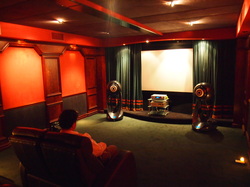 Audio Trends, tucked away in an industrial estate in a remote suburb of Melbourne is, in the words of Philippe Lebreton, the International Sales Manager of Cabasse, one of the best HiFi dealers in the World. It is certainly impressive, and every room was fitted out with a great sample of Cabasse speakers in honour of Christophe Cabasse visit that night right after the Melbourne Show. Audio Trends had invited a carefully selected audience and put on a great show of hospitality and marketing flair. Christophe spend some quality time alone with his "Ocean" system before the guests arrived. I was one of them... Christophe Cabasse is a great presenter, as you shall see in the video below, affable, funny and very knowledgeable, obviously. I have met George Cabasse a few times and Christophe has a striking resemblance to his father, not surprisingly I hear you say... Having said that, he is more casual and approachable, a sign of our times, but he certainly shares his father's passion for music and sound reproduction. I will let you enjoy the demo and retreat to my seat to enjoy the show: I hope you will enjoy it too!  After a number of emails and missed opportunities, I finally got an appointment to visit violet aka Jullien Thaller, the industrial designer behind the website dedicated to Elipson: www.passion-elipson.com. This website is all in French, so I was keen to give my English-speaking readers a glimpse of what Jullien had accumulated in terms of stories and Elipson vintage speakers. More recently, and you can't get better proof of somebody's passion than that, jullien has been working at Elipson and is responsible for the (amazing...) look of the new 4260s shown left. Jullien's home is an Ali Baba cavern of all things Elipson, and you barely walk into the living room that you are confronted with small and large "bits' of Elipson history! In good french tradition, Gaelle had baked a beautiful chocolate cake, and Jullien brewed a real cup of coffee which was very welcome after the 2-hour drive to his house from Gare de Lyon and a quick lunch with some of the managers of Cabasse (More on this later...). Jullien gave me the grand tour of his house and with his permission, I went on a rampage of photographs, like if I were a crime scene investigator. I felt like a child on Christmas Day, and Jullien have so many elipsoesque objects that it would take a coffe table book to give them justice. Most of these are in perfect condition, some waiting in his "hospital" in his basement awaiting various degrees of surgery. However, the main purpose of my visit was to do a A-B listening test between the old and the new, aka the reference 4050 against the new 4260 top of the range. Jullien has worked for another iconic French company, YBA, which makes amplifiers and CD players, (more on YBA soon...) so we had these massive monoblocs feeding the no less massive speakers, music by Jullien's iTunes library via ...DAC and the convenience of an iPad as a remote control for the whole thing. At 129kgs each, there is no way to move the 4260s...Besides, Jullien has spent quite a bit of effort to fine tune their position in the room, so we will have to be content with listening to the 4050s wheeled in front of the 4260s: not ideal, but the best we can do. I had listened to the 4260s at the Paris Hifi show, both in 2011 and 2012, and I had been impressed... Having a chance to reconnect with the 4050s that I had not listened to in probably 30 years was quite a treat: the common trait is the openness, the transient response, the quality and neutrality of the midrange. The 4260s seem to have a more extended response, and certainly a more articulate bass (38cm from PHL Audio...), but it feels more like a hifi speaker, where the 4050s make more music, and bring more life into it. Both are extraordinary performers, don't get me wrong, and it is quite fascinating that after 30 years or more they still work so well. I believe the configuration is one of the latest ones with all Siare drivers: woofer 31TE, midrange 21CP3 and tweeter TWM. One of the hair pulling things with Leon's contraptions, is the lack of continuity in the sourcing of the drivers. It seems that there are a myriad of combinations: Boomer Goodmans 38cm, Siare 31TE, medium Isophon, Supravox or Siare, Tweeter Audax TW8, Siare TWM, etc... It probably reflects the fact that the mold for the plaster enclosures last only for 150 units! If your eyes are good enough or if you are a Photoshop wizard, you might be able to find out what we have been listening to...things like Simon and Garfunkel" Bridge over the troubled water" and all sorts of things from the 80s and some tracks that I would not have chosen, but Jullien thought better of!
A very interesting afternoon indeed and a great many thanks for your hospitality Gaelle and Jullien! HiFI Antique, Paris and Disquantique, Montmarault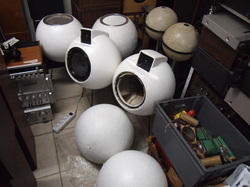 In the course of my research for this site, I stumbled upon this website www.hifi-antique.com and its related site www.disquantique.com, run by Patrick Pennetier in Paris et Bernard Billon in Montmarault in centre of France. I managed to pay a visit to Patrick in his Ali Baba like warehouse, well hidden in a courtyard in the middle of Vitry, a suburb on the south-east of Paris. No sign, just a bland painted steel door and a difficult to find doorbell...This is not the most salubrious part of the "banlieue" hence the discreet location, identified only by being the only business in that courtyard WITHOUT a sign: clever! Past the door, and this is the first glimpse of the fabulous collection assembled here by Patrick. It is obviously a work in progressm as Patrick buys famous vintage products and restore them to their previous glory and then resell them for a profit...bien sur! Patrick is so typically French looking, a chain smoker of self rolled cigarettes, that you expect to be sharing a glass of red wine any minute after the initial greetings...but, in good french tradition, this would not happen in the middle of the afternnon! Besides, I am that late because of a long and well lubricated lunch with a good friend of mine. But back to business, the second item I spotted is a very well preserved Hencot pro tape recorder, a unit I was once desperate to own - I finally bought a Stellavox instead because of the portability. It was (very well) built in a nearby suburb of Bourg-La-Reine, and was a three head, 19/38cm/s unit in the 70s But a lot of Patrick's inventory revolves around Elipson and all versions of them, probably recovered from the studios of Radio France. It is obviously difficult to find the original speakers from Supravox, as the newer versions are nothing like them - Patrick had both side by side, and although the chassis and motors are similar, the membrane and cone are completely different and there is NO WAY they can sound the same. Incidently, Supravox has once more gone bust and I doubt it will be revived, but who knows, I might be wrong. The Scientelec Regie ORTF was a latter version of the speakers used by Radio France in the 70s, an amplified 3 way designed by Mr delamare and subcontracted to Scientelec, more famous for their amplifiers than their speakers. The pair seen in my pictures have been nicely refurbished since my visit: Patrick has also a nice collection of British and German vintage products - nobody is perfect! I will finish with a typical 70s design product, a combined turntable amplifier and tuner with speakers to match! I used to own the turntable! HiFi Vintage - Christian Grados - Paris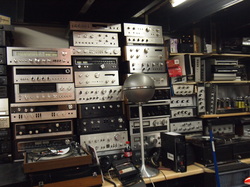 Bang pang in the middle of Paris, in the Halles quartier, between up and coming young fashion designers boutiques and century old delicatessen, Christian Grados is running a nice little business, selling vinyls (the original part of the business) and primarily vintage electronics, turntables and tape recorders. Speakers are scarse as space is at a premium. Christian takes great pride in his customer service: during my visit he spent a good half an hour changing a tiny little bulb in an alarm clock radio that was certainly over 40 years old for a customer much older than that, for whom this little piece of history was probably essential to his daily routine. I spotted a few favourites of mine: turntable from Braun, amplifier and tuner from Dual, Revox B77 tape recorder,a Merlaud amp being taken care of (they were once my client when working for HP...), Ampliton, Esart, two other famous brands in the 70s and many a Marantz and Pioneer, all in perfect condition, ready for you to fall in love again... Check his new website: www.hifivintage.eu and in the meantime, here are a few photos to feed your dreams:  When one lives just across the road from such a lovely old church, part Roman, part Gothic, with a spire covered in timber tiles (our North american readers would called them "shingles", I suppose...) and only an hour north west of Paris, one would be under the protection of the Gods... Such a happy person, Jean-Jacques Capello (JJC), just happens to live there in his family farmhouse, among 4000 vinyls and CDs and a great collection of French HiFi systems. After spending his life as a Principal of many high schools around France, educating young people on music and reproduction systems, JJC is more than willing to let you in (sur rendez-vous only...) in what would be otherwise a comfortable retirement, although I doubt this word will ever be part of his vocabulary! During the Paris Show this October 2011, JJC had reiterated his invitation to come and listen to all these goodies, and there was no way I was not going to find the time over the short five days I spent in Paris after spending time in Vendee with my Mum and sister. So, as JJC lives vaguely in the direction of CDG Airport, I managed to spend my last afternoon in Paris there (after a detour via the Kreon/Vismes showroom Place des Victoires, and getting lost trying to find Bertrand Valere, the affable owner of JMB Acoustique, himself vaguely on the way to Point Musiques...) By the time I did all this and shared a simple "steak frites" with Bertrand, I got to Point Musiques way past 3.00pm. JJC saw my relief to finally be there and sat me confortably in his generous leather sofa, letting me enjoy some introductory music, while he busied himself preparing coffee for both of us... It might be time for a couple of photos, so you get into the gist of the place! So, here we are, listening to Beethoven's Sonata #1 for Cello and Piano, played by Jacqueline Du Pre and Daniel Barenboim, an live recording by EMI made in 1976. We are using the Metronome Kallista CD player, Tosca preamp and amp, and the Ocellia Grandis Calliope Twin, deemed to have a 97dB/m sensitivity and a 30Hz to 30Khz bandwith. We are talking serious money here, so you expect serious results! And guess what, this was so far the most amazing HiFi experience of my life. I should actually say one of the most amazing musical experience ever! The thing is you didn't hear the equipment, just the music was flowing effortlessly and in a very concert like manner. On this particular recording you had a sense of the venue, the audience, and the players were right there, playing with each other in a brotherly synergy. You could hear the hands on the keyboard, the bow on the cords of the cello, and the air in between resonating with the subtleties of the music...beautiful! The coffee went almost cold, before we had a chance to extract ourselves from this sensational record! We then listened to Patricia Barber, a Chicago-based jazz singer described by Bill Zehme of Esquire Magazine, as early as 1994, in these words: "Patricia Barber makes jazz the way Tiffany makes crystal -- sleek and smart and dazzling. You must hush the world when she plays and listen to that which no one ever thought to do before with notes, with voice, with style penultimate. She is, for my money, the best jazz performer currently working the planet". Well, what a discovery: we listened to "Bye Bye Blackbird" and "Autumn Leaves" from her "Nightclub" CD, where piano, bass, drums and Patricia's voice, and its various intonations, proximity to the mike or breathing away from it, were perfectly "there". We could feel her presence, and all the tricks of the mixing deck in post-production...The balance of the whole band and Patricia's voice were particularly remarkable. We then listened to TWO different versions of the "Four Seasons" both recordings with Nigel Kennedy. I have one on EMI and English Chamber Orchestra, and JJC had that one plus another one with the Berliner Philarmoniker (plus another 25 versions of the Four Seasons, all catalogued on his MacBook Pro...more on this later). I just found a third version on Amazon... Anyway, Nigel's violin playing is not for the faint hearted - actually I had the chance to attend one of his concerts at the Sydney Opera House: what a treat! (Let's have another song...). Again all the intricacies of his virtuosity were there, raw for our ears, and no trace of sibilance, or other high frequencies nasties so common to even the best speakers on this sort of violin tunes. We did also play a number of songs on the "Classique" turntable from Pierre riffaud, fitted with a Denon DL103 and fed to a Tosca phono stage, and then the same Tosca gear that was used with the Kallista CD player. I cannot recall precisely what we listened to, but it was a combination of Jazz, male and female voices, probably some Mahler (we did listen to a lot of Mahler...). Well, interestingly enough, I could not hear significant differences between CD and vinyl with these two set-ups. Sure, we didn't have the same music on both media, but we had similar kind of music and instrument combinations on both, and I am sure you couldn't tell the difference if blindfolded: quite an achievement... By now, this excellent coffee IS cold, and JJC suggests we change speakers, which means going upstairs, where they are used in another room, and bringing them downstairs, which doesn't take my fancy... Anyway, I am so curious to hear the"petites" Ocellias that I agree... To my utter surprise, they are extremely light and quite easy to carry, if not for the narrow staircase! Time for more photos: The smaller Calliope.16 has ONE full range 16cm driver made by PHY-HP, as all the drivers used in the Ocellia range. Again, specifications call for 97dB/W/m and a bandwith of only 50Hz to 16KHz...
It is wired with copper, where the Grandis, uses silver wiring, all this contributing to reducing the price considerably. We listened to more music, some of the same as previously, but also some new ones like the Goldberg Variations of Bach, Simone Dinnerstein on the piano and a Telarc CD and more Mahler... Well, what can I say? Without splitting hair, my overall impression is that the petite Calliope is actually better than the Grandis. The overall balance, the accuracy of the timbres, the absence of filter, all this contributes to a delightful performance, always sweet and accurate with plenty dynamic range. At around a third of the price of the Grandis, this is certainly exceptional value, more WAF friendly and definitely right there with the sort of sound I like. Now, we have not played any rock or pop, but even on large symphonic ensembles as in Mahler, there was no trace of distortion, perfect transients and an overall sense of space and being "there" with the orchestra, or a single jazz vocalist and a small formation. Great achievement. was so enthralled by the music we played than my host had to bring me back to reality around 6.30pm, as my flight back to Australia was due to depart at 10.15, and I was supposedly a good 90mm away from CDG! I did make it in time (It took me a mere 60mns to get there, as it is freeway all the way...) with plenty of time to check-in my baggage (thanks Emirates for not charging me excess...) and some quality time with Mum on the phone before leaving France. The pleasure of this afternoon of music and Jean-Jacques's hospitality lingered with me all the way to Dubai, feeling like I was still on a little "nuage" populated with Nigel's violin acrobatics and Patricia's sexy voice, entre autres... Here we will write more in-depth articles about visits to Hifi shops, manufacturers, and equipment reviews
Stay tuned! |
Archives
June 2014
Categories
All
|




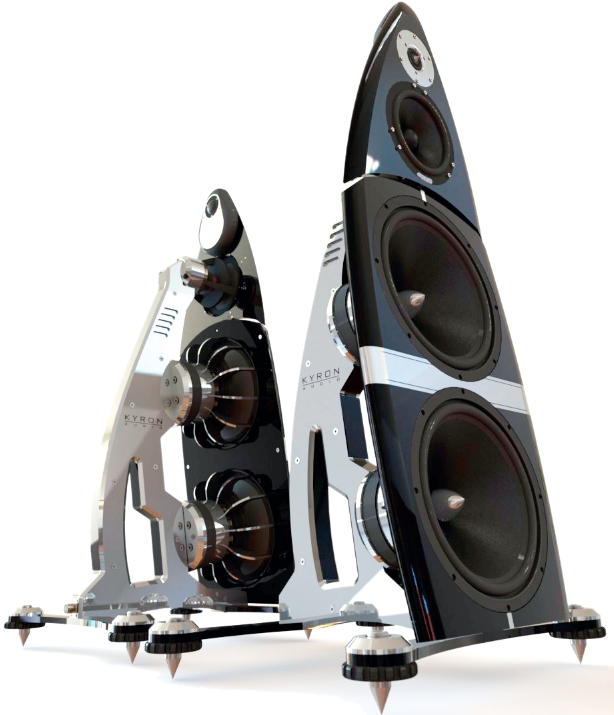


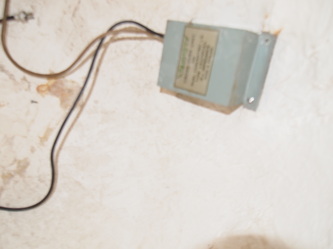







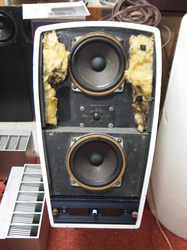


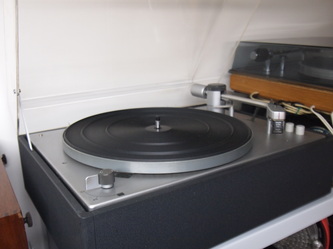
















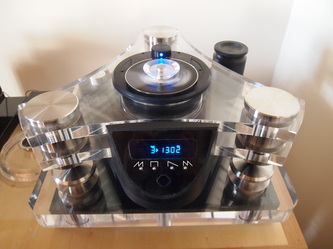
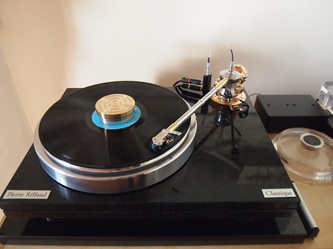






 RSS Feed
RSS Feed
